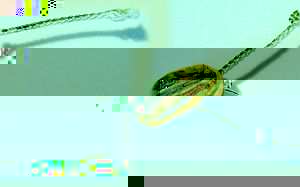

As with nearly all these fingernail flies, which I have used to create a range of patterns, you can prepare the fingernails in advance for the pattern you wish to dress.
Take the fingernail of the size required, and trace the outline on a piece of flat closed cell foam. I have used white here, but you can use any color you like; Now take a smaller fingernail, trace the outline again, and cut it out;

Take your fingernail, and using contact adhesive, ( I have used UHU here) or super glue, or whatever else you have available, glue the large piece to the fingernail. When set, glue the small piece on as well;
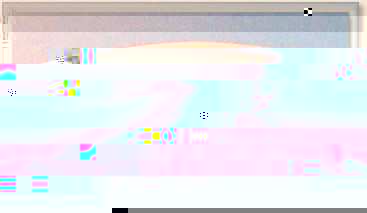
Allow to set thoroughly. You may prepare a number of these bodies in advance, and allow them to set. You should end up with something like this;
Now we need some frog's legs. There are several options here, and I will show a couple more for various patterns, depending on what they are to be used for, but here we are going to use polypropylene braid. This is available everywhere in various DIY markets etc. It is intrinsically buoyant, and does not absorb water. This is important for this fly. This is 2mm (nominal ) braid. Cut off two lengths of this as desired. Tie an overhand knot in each length, and fray one end of the length a little using a needle or similar. Place a drop of glue on the knots, and just before the frayed ends. This prevents the knots coming undone, and the frayed ends from unraveling any further. You may also melt the ends and flatten them if you prefer;
You can make these legs even more realistic, if you knot two strands together, and cut off one of the strands behind the knot, this imitates the thicker thighs of the frog very well, but reduces the action somewhat. I prefer the livelier action of the thin legs. You can now color the body and legs as desired. I have used a pretty universal green frog scheme here, using magic markers;
You need right and left legs. So make sure you color the right side of the cord. We don't want to waste such expensive material. ( 100 meters costs about a dollar ).
When doing this, always use your lighter marking pens first. As otherwise you will ruin the pens. The color scheme here is yellow, then green, then brown, and a couple of dark stripes on the back. If you want some really interesting color schemes, make up some bodies, and give them to your kids to color. This results in some amazing combinations, keeps your kids busy, saves them scrawling on your wallpaper, (take the markers from them after they have finished the frogs), and gives you more fly-dressing time.
Choose a suitable hook for the size of fly you are dressing, and mount it in the vice. The hook should be long enough so that the eye is not obscured, and the bend is slightly beyond the body of the fly. Start your thread as normal, and take it back to the position shown. Wind in some black wool at the rear, and then some red wool at the front. This simulates the "guts" of the frog when seen from below. Whip finish and varnish. Now take your body, and place a small bead of glue in the centre of the nail, and then place the body as shown. Put aside to set.
Now take your legs, put a few spots of glue where you want them, place the legs a shown, and put aside to set;
Take your epoxy ( if you are only making one fly just a small amount of 5 minute epoxy is sufficient. If you are making half a dozen, use thirty minute epoxy). Run the epoxy into the nail using a cocktail stick or similar. It should be about level with the nail rim, and no more! You can use a piece of blu-tac or similar putty to hold the nail level while you do this. You should end up with this;
Allow to set thoroughly. Now, take the fly, and paint the belly with pearl glitter flash nail varnish. If you wish, you may also give the top side a coat of hard as nails or similar. This is the result from various angles; Of course you may allow your artistic talents free rein here, adding eyes, and all that sort of thing, but it doesn't make any difference to the fish! Although you may impress a few fellow anglers with some "very realistic" versions.
There are a couple of versions of this fly, which behave completely differently, and are fished in different ways. As the coloration of frogs varies considerably according to type and locality, you will need to observe your local frogs to get the color scheme you need. The first one shown here is the floating version. I like to fish this on a sinking line, and long leader, near lily pads, weeds etc. Draw the fly towards you, it causes a small commotion or a "plop" depending how you move it, then dives, and then swims up to the top again like a real frog. It will also be taken when stationary. Perch and pike will really thump it hard, so be prepared! I have never caught a freshwater bass, but I imagine this fly will work well for them as well, and also for various panfish. Indeed, it should catch any fish that eats frogs.
If you fish it on a floating line, it "swims" across the surface very realistically causing a small commotion, again like a real frog. The weight of the hook and epoxy is sufficient to ensure that it sits in the film with the legs trailing. If it does not land right side up, which occasionally happens, just give it a twitch and it flips over.
Hope you enjoy dressing and fishing this one. It has turned up some lunker perch for me! It is extremely durable, unlike many foam flies, very easy to cast and use, and very quick to make. Of course, a couple of pike will chew it up a bit! Once again, you can easily make a dozen in an hour. ~ TL MC